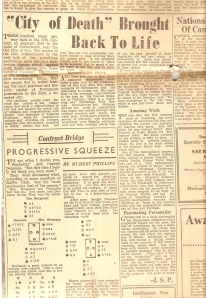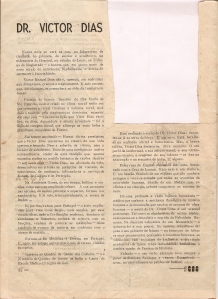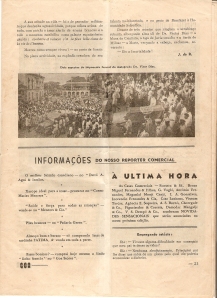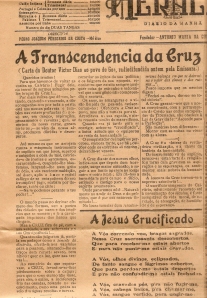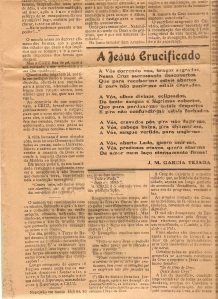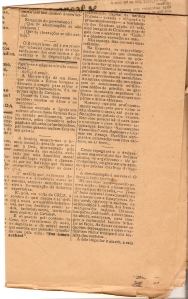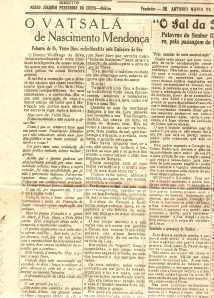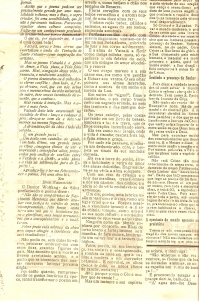Remembering Dr Victor Manuel Dias February 14, 2008
Posted by Luis Dias in Uncategorized.add a comment
Curriculum vitae
Born 10 November, 1892, on the picturesque island of Santo Estevam (or St Stephen, today known as Jua, which itself means island in Konkani), the firstborn child to Dr Miguel Caetano Dias & Veronica da Silva Dias .
Certified as volunteer to D. M Colonial on 26 January, 1917.
Promoted to Lieutenant-Doctor on 18 March 1921.
Qualifications:
-
Diploma of the School of Tropical Hygiene (Curso da Escola de Medicina Tropical)
-
MBBS (Doutor em Medicina e Cirurgia), Universidade de Lisboa, 29 June 1920.
-
Authorised by the Ministry to specialise at Berlin, for a year, sem direito aos vencimentos.
-
Posted in India by Portaria Ministerial, 30 June 1923
-
Appointment confirmed 1925
-
Captain (Capitão) 1926
-
Sanitary Inspector Mormugão 1927
-
Director of Chemical Analyses (Director de Análises Químicas) 1928
-
Assistant (Assistente) of the Bacteriological Institute 1931
-
Vogal of the Administrative Tribunal and of Accounts 1952
-
Major 1931
-
Ten.-Coronel 1941
-
Colonel. 30 June 1948
-
Dois louvores do Governo Geral da India
-
Ordem de Gră- Cruz 1931
-
Bachelor of Law, Faculty of Law, University of Lisbon (Bacharel formado em Direito pela Faculdade de Direito da Universidade de Lisboa)
-
Diplomate of Science (Section- Physical & Natural Sciences) from the Faculty of Sciences of the University of Paris, France. (Diplomado com o Curso de Sciencias (Secção- Sciencias Fisicas e Naturais) pela Faculdade de Sciencias da Universidade de Paris).
-
Diplomate of the School of Tropical Medicine, Lisbon
-
Diplomate, Special Course in Hygiene, Institute of Hygiene, Lisbon
-
Thesis at the Faculty of Medicine, Lisbon. Degree of Doctor in Medicine & Surgery, topic: “Anti social reactions of alcoholics”
He is credited with having given the first ever radio broadcast in Goa (Dicioníario de Literatura Goesa, by Aleixo Manuel da Costa, pages 350-351)
VÍTOR MANUEL DIAS, Lieutenant-Colonel Doctor (10/11/1892) January 27, 2019
Posted by Luis Dias in Uncategorized.add a comment

Formou-se em Medicina e em Direito, pela Universidade de Lisboa e em Ciências Físicas e Naturais, pela Universidade de Paris. Diplomou-se pela Escola de Medicina Tropical e pelo Instituto de Higiene, ambos em Lisboa.
Foi nomeado para o Quadro de Saúde de Angola, em 1923. Dali foi transferido para a Índia como Lente efectivo da Escola Médica de Goa. Depois passou para o Quadro de Saúde como Inspector e, mais tarde, como Director de Serviço.
Foi o responsável pela campanha de saneamento que erradicou a malária de Velha Goa entre 1948 e 1949.
Ainda em Goa, foi director da Leprosaria Macasana e do Sanatório de Tuberculose, tendo também fundado a companhia farmacêutica Laboratórios Sida, especializada em doenças pulmonares.
Foi também Vogal do Tribunal de Contas.
Em Berlim e em Roma, anteriormente, fora Assistente dos respectivos Institutos de Tuberculose. Foi autor dalguns trabalhos de cariz médico e colaborador da revista «Presse Medicale» e «Lancet».
Multifacetado, registou a patente para a sua inovadora encubadora aviária «Lux», em Lisboa. Foi pioneiro na emissão radiofónica (1943), e na utilização do aparelho de raio-x portátil, para uso na medicina privada, em Goa.
Foi alvo de dois louvores do Governo Geral da Índia, e recebeu a insígnia da Ordem d Grã-Cruz (1931).
Filho primogénito do General-Médico Miguel Caetano Dias, nasceu na ilha de Santo Estevão, hoje Jua (Ilha, em Concani).
segundo «Dicionário de Goanidade» de Domingos Soares Rebelo
English translation of the above text:
Graduated in Medicine and Law, from the University of Lisbon and in Physical and Natural Sciences, from the University of Paris. He graduated from the School of Tropical Medicine and the Institute of Hygiene, both in Lisbon.
He was appointed to the Angolan Health Board in 1923. From there he was transferred to India as an effective ‘Lente’ of the Goa Medical School . He then moved to the Health Care Board as an Inspector and later as a Service Director.
He was responsible for the sanitation campaign that eradicated the malaria of Velha Goa between 1948 and 1949. He was also
in Goa, director of Leprosaria Macasana and of the Sanatorium of Tuberculosis. He also founded the pharmaceutical company Laboratorios Sida, specialized in pulmonary diseases.
He was also a Member of the Court of Auditors.
In Berlin and Rome, he had previously been Assistant to the respective Institutes of Tuberculosis. He has authored some medical work and is a contributor to the journal Presse Medicale and Lancet.
Multifaceted, he registered the patent for his innovative aviary encoder “Lux” in Lisbon. He pioneered radio broadcasting (1943) and the use of portable x-ray apparatus for use in private medicine in Goa.
He was the recipient of two honours by the General Government of India, and received the insignia of the Order of the Great Cross (1931).
The eldest son of General-Doctor Miguel Caetano Dias, he was born on the island of Santo Estevão, today Jua (Island, in Concani).
according to «Dicionário de Goanidade» by Domingos Soares Rebelo.
Victor Manuel Dias – A Renaissance Man June 7, 2009
Posted by Luis Dias in Press.3 comments
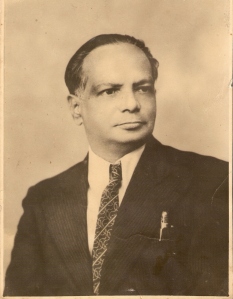
By Dr. Luis Dias
(Published in Herald Sunday Mirror, Goa, 7 June 2009)
11 June marks the 60th death anniversary of a truly remarkable man, Colonel Doctor Victor Manuel Dias, Director of Health Services in pre-Liberation Goa.
His sudden death, at 57, at the peak of his illustrious career, due to a cerebral haemorrhage, in 1949, sent shock waves throughout Goa and also in newly-independent India. Tributes followed, in the local and the Indian press. In its obituary tribute, The Sunday News of India described him: “Generous to a fault, discharging his Hippocratic obligation with a scrupulous regard for the poor, the best of companions, he was a fascinating personality, by whose loss his country and his people will be the poorer”.
The Sunday Standard, in its tribute added: “A profound scholar with an academic record of unusual brilliance, Victor Dias embodied a great family tradition. His father, General Miguel Caetano Dias, was Director of Public Health in Portuguese India for upwards of thirty years….Victor himself was a Doctor in Medicine of Lisbon University, a Doctor in Law of the historic University of Coimbra, and a Bachelor in Science, of Sorbonne, Diplomate of the School of Tropical Medicine in Lisbon. In Berlin where he studied for some years, he worked with Professor Friedman, discoverer of the well-known TB vaccine named after him, and later he spent a year at Carlos Forlamini’s world-renowned Mussolini Institute where lung collapse therapy was first discovered and developed. More recently he became interested in the new X-ray and radium therapeutics and went to Berlin to study them.”
Col. Dias was nominated to the Department of Health in the Portuguese colony of Angola , from where he was transferred to Goa in 1923. After several years as a Professor at the Medical College in Goa, Col. Dias was appointed Director of Public Health in 1947.
In his practice, his patients included the whole gamut of society of his day, and included the venerable Fr. Agnel.
For upward of fifteen years, Col. Dias was the special surgeon in charge of the body of St. Francis Xavier and had the duty of inspecting annually the Saint’s incorruptible remains and reporting on them to the Government and the ecclesiastical authorities of Goa and Portugal.
The Sunday Standard corroborated what the local press, including the Heraldo, had reported extensively over the last year. “His last work, completed a few weeks before his death, was historic, and should be a fitting memorial to a man whose only justification, as he often said to me, was service of his fellowmen. The work was the rehabilitation of the ancient city of Old Goa which had lain uninhabited and uninhabitable since the seventeenth century when it was abandoned overnight by its population of 3,00,000 citizens panic-stricken by a mysterious malady for which no treatment has ever been discovered.
Till last year nobody outside the half dozen surviving old churches spent a single night in Old Goa for fear of contracting the disease, a peculiarly malignant type of malaria which resisted every known treatment. In May 1948 Col. Dias started his “Blitzkrieg” for the restoration of the capital.”
The Sunday News of India, in its article “City of Death brought back to life”, elaborated: “…the work of resanitation was carried out with military precision and speed: 800 wells were buried, every possible reservoir of infection was sterilised, mosquitoes were literally exterminated and their breeding places wiped out…. It took three months, at the end of which not a single mosquito remained, and the cleaned and disinfected city was pronounced habitable once more. The Portuguese Ministry for Colonies appointed a commission consisting of a member of the Rockefeller Foundation from New York and a Professor of the Tropical Institute in Lisbon to inspect the city. Their laconic report, as cabled to the Minister, read: “No more mosquitoes in the Old Goa, which is now free from death and disease”.
Col. Dias was President of the Leprosaria de Macasana and of the Tuberculosis Sanatorium. Besides this, he was a man of many interests. He founded and headed the Laboratorio Sida, a pharmaceutical company that created novel drugs in the treatment of several illnesses which ranged from bronchial asthma, to pulmonary tuberculosis, to lung infections, leprosy and gout to name but a few. Contemporaneous accounts from physicians and patients of the time indicate their efficacy.
He invented and patented an electric incubator “Lux” for the hatching of chickens, which was innovative for its time, as it employed a property of light described as luminosity. The invention was registered with the Ministry of Commerce and Industry in Lisbon, with a national patent.
Col. Dias was among the first physicians in Goa to acquire a portable X-ray machine for his private practice, having studied in the field of radiology in Berlin. His work was published in reputed medical journals such as the Lancet, and the Presse Medicale in Paris. He was on the committee of the Instituto Vasco da Gama, a prestigious institution in Goa.
A multifaceted man, he was a radio enthusiast, and gave the first ever radio broadcast in Goa from his house in Altinho. This fact is corroborated in Aleixo Manuel da Costa’s Dicionário de Literatura Goesa in his summary of Victor Dias’ life (page 350), and by his peers living today. He often spoke on the radio on various issues and the text of the speeches were reproduced in the local papers.
The Sunday Standard captured his essence thus: “More than all this, Victor Dias was a fascinating companion, with a gift of conversation which ranged from the art of Picasso and the aberrations of Dali, to Shakespeare, Kant, Bach and Boogey-woogey—literally from Socrates to ships and sealing wax, without being boring or didactic. Of courtly manners and polished speech, an orator in three languages with command of a dozen, he was epicure in the art of living, an artist in everything he did, with an inexhaustible charity that loved everybody and looked down on nothing. Above all he was modest and had a rich sense of humour.”
A memorial service for this remarkable Renaissance man will be held at St Inez church on 11 June at 9.30 am, followed by tributes at his grave.
Physician to Venerable Fr Agnelo January 15, 2009
Posted by Luis Dias in Uncategorized.add a comment
As a man lives so does he die. A good life climaxes in a good death, a beautiful life, in a beautiful death, a peerless life, in a peerless death, and a holy life, in a holy death. When death knocked at the door of Fr. Agnelo he was prepared to meet it. His death was the apotheosis of his saintly life. In 1927 his weak health seemed to be creaking soon. “The beast of burden”, as he used to call his body, could not stand the stain any longer of his ceaseless lab ours, austerities and vigils. His near and dear ones offered to get him traded at home for his aliments, but his superior desired, as is but natural in religious communities that he should avail himself of the medical care of Dr. Victor Dias in the Monastery of Pilar itself.
